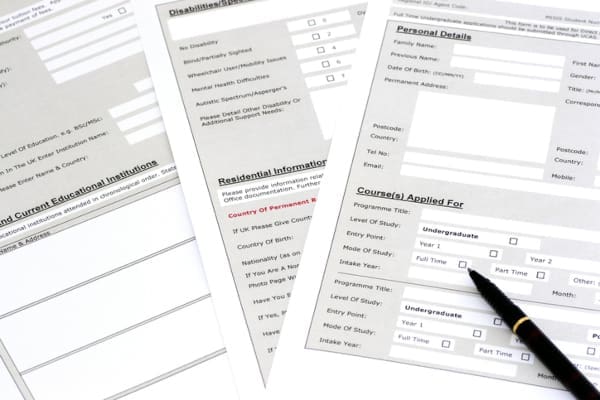From Prospective to Enrolled to Graduated: Leveraging Data in All Stages of the Student Journey
Here at the start of the 2025-2026 school year, a lot of higher education institutions are facing the reality of the “enrollment cliff ” — the long-anticipated culmination of a variety of demographic and social trends that are expected to lead to a 15% drop in the number of college students between 2025-2029. This presents a new challenge in higher education as schools and colleges look for efficient and effective ways to reach prospective students, get and keep them enrolled, and support them all the way to graduation.
Luckily, we have more tools than ever before that help us collect data and leverage it in order to accomplish these goals.
Luckily, we have more tools than ever before that help us collect data and leverage it in order to accomplish these goals.
Using Data for Recruitment and Enrollment
When we’re talking about “data” here, a lot of what we’re referring to is predictive analytics, which help schools figure out which students are most likely to apply, enroll, and succeed so they can allocate time and resources accordingly. These tools can shape your strategies for targeting and enrolling prospective students in a number of ways:
Personalized Campaigns and Communication
We’ve discussed the importance of personalization before. People want digital marketing and messaging to speak to them, their needs and their goals. By using data analytics, you can take an extremely broad category of leads — “interested prospective students” — and drill down to create customer journeys and audience segments by looking at their browsing habits, what pages they lingered on longest, their social media accounts, their interests, and more. Instead of a generic, enroll-today email or message, you can instead send the potential student communication that speaks more directly to what that person is looking for.

Resource and Campaign Allocations
If you’re pouring money into a marketing channel that is not producing leads that convert, you’re wasting both your time and your money. Utilizing data analysis, you have an opportunity to get a much clearer picture of your institution’s digital footprint, where are the best places to invest, and how you’re stacking up against competitors. You can focus on the right marketing channels for your school and your brand, plus also open up new potential digital spaces where your ideal demographic exists with low awareness of what you have to offer.
Omnichannel Messaging
Part of the personalization aspect of digital marketing is a unified message across multiple channels. In today’s competitive marketing space, you need to be able to meet prospective students everywhere they’re at, consistently. Data can help you develop campaigns for different student groups and then implement it across the digital landscape in a cohesive move.

Streamlining the Application Process
Nothing is going to turn off a potential student quite like a complicated and confusing application process. The rockier the process, the more likely they will abandon it unfinished and leave you with a cold lead. Utilizing data, you can get a clear picture of where users are dropping off or abandoning the process so you can address it, as well as setting up instant help via chatbots and real-time updates.
Identifying At-Risk Applicants
One of the big places that schools lose students is at the application and enrollment stage. Data analytics tools can be leveraged to draw your attention to prospective leads who are showing markers of abandoning their applications so that you can step in and offer more personalized attention. It helps you demonstrate encouragement and engagement that make all the difference when it comes to getting students through enrollment.
Time-Saving and Effort-Saving
Among the benefits of leveraging data is the time and energy it saves you and your staff, freeing you up to focus on growing your institution’s future. Data and data analytics tools can centralize and unify your leads and messaging in one place, automate the workflows to maintain consistency, and process insights in real time so you can stay responsive and dynamic.
Using Data for Instruction and Retention
As important as it is to get students through the door, it is equally important to retain them and shepherd them all the way through to graduation. Once they step onto your campus, there is a lot of different kinds of data you can gather and use to inform your instruction, curricula, and support services. This includes things like:
- Academic performance, like grades and test scores
- Student achievements
- Educational participation and attendance
- Student involvement
- Student behavior and classroom conduct
- Emotional well-being and mindset
Want to stay up to date with the news and resources from EdwardsSchoen?
Sign up for our monthly newsletter to stay in the know!
Personalized Learning and Instruction
The importance of personalization continues into the classroom. We’ve been aware for a while now that not everyone learns the same, and a successfully run school will reflect that in its curricula. By utilizing data, you can collect information on student performance and preferences for your faculty and educators, and they can then use that to inform their lesson plans and content.
Closing Knowledge Gaps
Not every student is going to come in on the same educational playing field or advance through the curriculum at the same rate as their peers. These differences — knowledge gaps — can be incredibly discouraging to some students and cause attrition, but collecting and analyzing data can be the solution here, too. By gathering information on individual student performance, you can pinpoint subject areas and skills that one or even multiple students are struggling with so that you can dedicate more resources to supporting them.
At-Risk Student Identification
Similar to the situation with knowledge gaps, there are some markers that will put a student more at risk of falling behind or dropping out, whether that’s their grades, their attendance, their work status, or something else. Data analytics can identify these issues sometimes earlier than human staff, giving you and your faculty a better chance at intervening to help them. And early intervention can make all the difference.
Student Support Systems
This part goes beyond the classroom to look at how data can inform the environment you foster at your school and the services you should invest in. Taking all the data you learn in the previous sections about how students are or are not succeeding, you can then make informed decisions about what you may need to provide, whether that’s tutoring, peer mentoring, writing centers, digital libraries, etc. Surveying and gathering information on student responses to your campus can help influence gaps in social and environmental support that might help cultivate a feeling of belonging, including things like wellness initiatives and student organizations.

Data-Driven Admissions for Student Success
To be perfectly honest, this article is a pretty high-level overview on how data gathering and analytics can transform your student admissions and retention funnel. What tools to use, how to set everything up, how to process and best leverage the information you get — that can get into the weeds really fast. But choosing not to utilize data would put your higher education institution at a huge disadvantage. A digital marketing agency that specializes in higher education can be an ideal partner to guide you through all the options out there and ensure you’re utilizing ones that work for you and your school.
